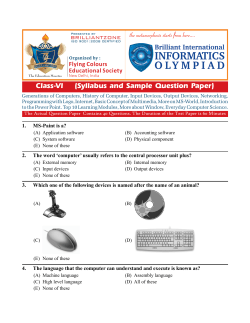
Paper - Embarrassing Interactions
Embarrassing Interactions Sebastian Deterding PlaIT Lab, Northeastern University Boston, MA, 02115, USA deterding@neu.edu Andrés Lucero Mads Clausen Institute, University of Southern Denmark, DK-6000 Kolding, Denmark lucero@acm.org Jussi Holopainen GEElab, RMIT University 76131 Karlsruhe, Germany jussi.holopainen@rmit.edu.au Chulhong Min KAIST Daejeon, 305-701, Republic of Korea chulhong@nclab.kaist.ac.kr Adrian Cheok City University London EC1V 4PB, London, UK adrian.cheok.1@city.ac.uk Annika Waern Uppsala University Box 513, 751 20 Uppsala, SE annika.waern@im.uu.se Steffen Walz GEElab, RMIT University 76131 Karlsruhe, Germany steffen.walz@rmit.edu.au Abstract Wherever the rapid evolution of interactive technologies disrupts standing situational norms, creates new, often unclear situational audiences, or crosses cultural boundaries, embarrassment is likely. This makes embarrassment a fundamental adoption and engagement hurdle, but also a creative design space for human-computer interaction. However, research on embarrassment in HCI has remained scattered and unsystematic so far. This workshop therefore convenes researchers and practitioners to assemble and advance the current state of research on embarrassing interactions. Keywords Embarrassment; shyness; intercultural HCI; crosscultural UX ACM Classification Keywords Permission to make digital or hard copies of part or all of this work for personal or classroom use is granted without fee provided that copies are not made or distributed for profit or commercial advantage and that copies bear this notice and the full citation on the first page. Copyrights for third-party components of this work must be honored. For all other uses, contact the Owner/Author. H.5.m [Information Interfaces and Presentation] Miscellaneous; H.5.3 [Group and Organization Interfaces]: Theory and models. Copyright is held by the owner/author(s). Embarrassment is a basic self-conscious, social emotion that arises when a person perceives that she is perceived to have behaved inappropriately or incompetently relative to her situational role expectations [13,17]. Embarrassment is centrally CHI'15 Extended Abstracts, Apr 18-23 2015, Seoul, Republic of Korea ACM 978-1-4503-3146-3/15/04. http://dx.doi.org/10.1145/2702613.2702647 Introduction involved in regulating social interaction, ensuring that individuals keep to situational norms and engage in repair and appeasement if they have broken them [8,9,25]. It is closely linked to shyness – avoiding engagement in social situations out of anxiety that one may lack competence to meet expectations and thus, embarrass oneself. Due to its rapid pace of innovation and change, human-computer interaction (HCI) is especially rife with embarrassment potential: Novel interactive technologies create new interactions, situations, and audiences with lacking, unclear, or even conflicting norms and role expectations. Existing Work One prominent example for this is context collapse [5]: because users can share information on social networking sites (SNS) across multiple typically distinct audiences in which individuals typically enact different roles and identities (workplace, family, friends), embarrassing “miscommunications” are common [14]. However, SNS are far from the only HCI arena where researchers observed embarrassment: • the novelty of and thus lacking situational norms and scripts for interactive art installations generates “visitor shyness” [24]; • mobile telephony makes situationally inappropriate information accessible to bystanders, and leads callers to not appropriately regulate volume and content of their conversation [15,18,19]; • the novelty of human-robot interaction is a frequent source of embarrassment; conversely, robots that signal embarrassment are perceived as more sociable [7,10]; • online behavior tracking can lead to embarrassing targeted advertising displays and suggested • • • • content when others observe or use an individual’s browser [1]; many ubiquitous computing applications explore novel ways of users interacting and user activity being displayed in public, assuming and requiring extrovert users, disregarding shy users afraid of embarrassment potentials [2,3,6,16,22]; on-body and erotic interfaces are so novel and intruding on social norms of personal space and intimate behavior that they require special design attention to ameliorate embarrassment [11,12,21,26]; novel experimental, pervasive and body games explore embarrassment as a positive design goal [12,26,27], following the rationale that “uncomfortable interactions” [4] can have powerful artistic, educational, and political effects; different cultural norms of face and face saving make (computer-mediated) intercultural communication and interactive systems travelling across (and ignoring) cultural differences a common site of embarrassment [19,28]. In short, wherever novel HCI systems create lacking, unclear, or clashing situational norms or publics, shyness and embarrassment present likely sources of negative experience and hurdles to engagement and adoption, but also a productive artistic design space. Yet embarrassment has largely figured as a secondary research concern and surprising finding in HCI rather than as a subject of focused study. There has been no systematic attempt to bring together findings across domains, let alone focus on forms, conditions, or processes of embarrassment in HCI. Workshop Goals In light of this situation, the organizers of this workshop consider it high time to bring together researchers from different domains to jointly map the current state of research on embarrassment in HCI, and chart a future research agenda for its systematic study. Given that embarrassment is a process and emotion wound up in culturally shared social norms, and given that crosscultural communication and technology use are a chief domain of embarrassing interactions, the location and theme of CHI 2015 provides an especially good opportunity for this topic, as it invites and allows dialogue and comparison across eastern and western cultures. Workshop Questions • • • • • What are causes, conditions, processes and forms of embarrassment in HCI? How does culture affect embarrassment in HCI? What cultural differences in embarrassment affect system design and use, and do these norms affect how systems from other source cultures are adopted and used? What are specifics of embarrassment in intercultural HCI? How does embarrassment impede adoption of and engagement with interactive systems? How can we mitigate (fear of) embarrassment as an undesired user experience? How we design for embarrassment as a desired experience in art, education, or activism? Participants and Expected Interest Exploring the current state of research on embarrassing interactions is of direct interest to all researchers and practitioners who study or have to grapple with (novel) interactive systems that might disrupt or render unclear standing situational norms and role expectations, especially if interaction has a (mediated) public: mobile communication; ubiquitous computing; computermediated intercultural communication; interactive art; experimental games; body interfaces; interaction in public settings; and social software. It also immediately speaks to researchers and practitioners in intercultural HCI, and anyone working on social computing or the social psychological dynamics of HCI more generally. References [1] Agarwal, L., Shrivastava, N., Jaiswal, S., and Panjwani, S. Do Not Embarrass: Re-Examining User Concerns for Online Tracking and Advertising. SOUPS ’13, ACM Press (2013). [2] Balaam, M. Designing for Social Connectedness in Shyness, Schools and Stroke Patients. CHI’10 Social Connectedness Workshop, (2010). [3] Bedwell, B. and Caruana, T. Encouraging spectacle to create self-sustaining interactions at public displays. PerDis ’12, ACM Press (2012), 1–6. [4] Benford, S., Greenhalgh, C., Giannachi, G., Walker, B., Marshall, J., and Rodden, T. Uncomfortable interactions. CHI ’12, ACM Press (2012), 2005–2014. [5] Boyd, D. Taken Out of Context: American Teen Sociality in Networked Publicy. 2008. [6] Chalmers, D., Fitzpatrick, G., Scott, S., and Wakeman, I. Supporting Shy Users in Pervasive Computing (Full Proposal). Sussex, 2008. [7] Choi, J.J., Kim, Y., and Kwak, S.S. Are You Embarrassed?: The Impact of Robot Types on Emotional Engagement with a Robot. HRI’14, ACM Press (2014), 138–139.1. [8] Goffman, E. Embarrassment and Social Organization. American Journal of Sociology 62, 3 (1956), 264–271. [9] Goffman, E. Interaction Ritual: Essays on Face-toFace Behavior. Pantheon Books, New York, 1967. [10] Han, B.S., Hong Yee Wong, A., and Li, H. Using design methodology to enhance interaction for a robotic receptionist. RO-MAN’10, IEEE (2010), 797–802. [11] Hobye, M. and Löwgren, J. Touching a Stranger: Designing for Engaging Experience in Embodied Interaction. International Journal of Design 5, 3 (2011), 31–48. [12] Huggard, A., Mel, A. De, Garner, J., Toprak, C.C., Chatham, A., and Mueller, F. Musical Embrace: Facilitating Engaging Play Experiences through Social Awkwardness. CHI ’13 EA, (2013), 3067–3070. [13] Keltner, D. and Buswell, B.N. Embarrassment: its distinct form and appeasement functions. Psychological Bulletin 122, 3 (1997), 250–70. [14] Litt, E., et al. Awkward Encounters of an “Other” Kind: Collective Self-Presentation and Face Threat on Facebook. CSCW’14, ACM Press (2014), 449–460. [15] Love, S. and Perry, M. Dealing with Mobile Conversations in Public Places: some implications for the design of socially intrusive technologies. CHI’04, ACM Press (2004), 1195–1198. [16] Lucero, A., Holopainen, J. and Jokela, T. MobiComics: collaborative use of mobile phones and large displays for public expression. MobileHCI '12, ACM Press (2012), 383-392. [17] Miller, R.S. Embarrassment: Poise and Peril in Everyday Life. The Guilford Press, New York, 1997. [18] Min, C., Lee, Y., Pushp, S., et al. Uncovering embarrassing moments in in-situ exposure of incoming mobile messages. UbiComp ’14 Adjunct, ACM Press (2014), 1045–1054. [19] Monk, A., Carroll, J., Parker, S., and Blythe, M. Why are mobile phones annoying? Behaviour & Information Technology 23, 1 (2004), 33–41. [20] Marcus, A. Cross-cultural user experience design. SIGGRAPH Asia 2011 Courses, ACM Press (2011). [21] Profita, H., Clawson, J., Gilliland, S., et al. Don’t Mind Me Touching My Wrist: A Case Study of Interacting with On-Body Technology in Public Social Acceptability of Wearable Technology. ISWC’13, ACM Press (2013), 89–96. [22] Reeves, S. Designing Interfaces in Public Settings: Understanding the Role of the Spectator in Human-Computer Interaction. Springer, London, 2011. [23] Rubin, K.H., Coplan, R.J., Bowker, J.C., and Menzer, M. Social withdrawal and shyness. In P.K. Smith and C. Hart, eds., The Wiley-Blackwell Handbook of Childhood Social Development. Wiley-Blackwell, Malden, MA, 2013, 434–452. [24] Scott, S., Hinton‐Smith, T., Härmä, V., and Broome, K. Goffman in the Gallery: Interactive Art and Visitor Shyness. Symbolic Interaction 36, 4 (2013), 417–438. [25] Scheff, T.J. Shame and the Social Bond: A Sociological Theory. Sociological Theory 18, 1 (2000), 84–99. [26] Segura, E.M., Waern, A., Moen, J., and Johansson, C. The Design Space of Body Games: Technological, Physical, and Social Design. CHI’13, ACM Press (2013), 3365–3374. [27] Toprak, C.C., Platt, J., Ho, H.Y., and Mueller, F.F. Cart-Load-O-Fun: Designing Digital Games for Trams. Fundamentals of Digital Gaming 2013, (2013). [28] Zhao, C., Street, D.L., and Hinds, P. How and To Whom People Share: The Role of Culture in SelfDisclosure in Online Communities. CSCW’12, ACM Press (2012), 67–76.
© Copyright 2025











